Apr 27 2016
Graphene is a one atom thick sheet, and is made up of carbon atoms. Although graphene possesses a long list of properties, not one of those is magnetism.
 This is a picture of hydrogen atoms in graphene. (Credit: CIC nanoGUNE)
This is a picture of hydrogen atoms in graphene. (Credit: CIC nanoGUNE)
In partnership with the Autonomous University of Madrid and the Institut Néel of Grenoble, NanoGUNE researchers have for the first time demonstrated how atomic-scale magnetic graphene can be produced using a hydrogen atom.
The team showed that when a hydrogen atom is absorbed on a graphene layer, a vast region of the graphene is magnetized. Selective manipulation of hydrogen atoms can create magnetic graphene with atomic precision. The study was featured in the Science journal.
Hydrogen atoms are known to have the smallest magnetic moment, which determines the magnitude of force exerted by a magnet in various directions.
In other words, we can all remember having held a magnet in our hands and seeing how it was capable of attracting or repelling another magnet at a certain distance, which was greater or smaller depending on its power. Well, what really determined this behavior was the magnetic moment of our set of magnets. The distance at which we began to feel the appearance of a force was specified by the spatial extension of their magnetic moments, and the fact that the force should attract or repel depended on the relative orientation between them; that is why when one of the magnets was turned round, they then attracted or repelled each other or vice versa.
Our work reveals how when a hydrogen atom touches a graphene layer it transfers its magnetic moment to it. In contraposition to more common magnetic materials such as iron, nickel or cobalt, in which the magnetic moment generated by each atom is located within a few tenths of a nanometer, the magnetic moment induced in the graphene by each atom of hydrogen extends several nanometers, and likewise displays a modulation on an atomic scale.
Miguel Moreno Ugeda, Researcher, NanoGUNE
The experiments were carried out with the help of a tunnel-effect microscope. This microscope allows matter to be imaged and manipulated on an atomic scale. the results show that these induced magnetic moments interact strongly with each other at great distances (compared with the atomic scale) while also abiding by a particular rule: the magnetic moments are added or neutralized depending critically on the relative position between the absorbed hydrogen atoms. What is more, and of equal importance, is that “we have managed to manipulate the individual hydrogen atoms in a controlled way, and this has enabled us to freely establish the magnetic properties of selected regions of graphene,” stressed Moreno.
In the quest for magnetism
Since the discovery of graphene in 2004, scientists have been trying to add magnetic properties to the huge number of characteristics of this purely 2D material. Laboratories across the globe are keen about this magnetic property because graphene serves as a perfect material in the field of spintronic technology.
Spintronic technology is a promising technology, as it provides a potential substitute for conventional electronics by transmitting both electronic and magnetic data simultaneously. This could pave the way for next-generation computers.
The results obtained in this work, which indicate the possibility of freely generating magnetic moments in the graphene and showing how these moments can communicate with each other over great distances, are paving the way for a promising future for this material in the emerging field of spintronics.
Miguel Moreno Ugeda, Researcher, NanoGUNE